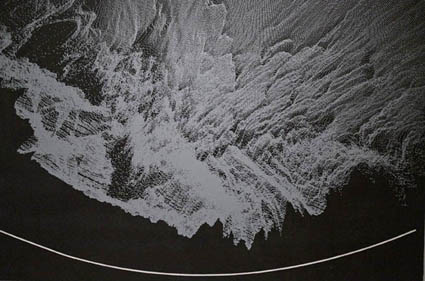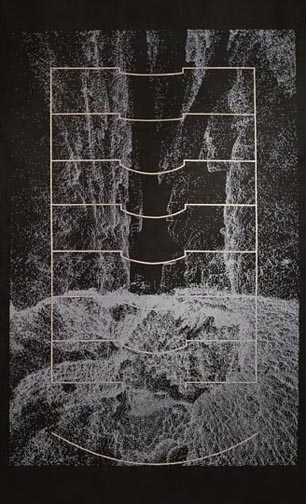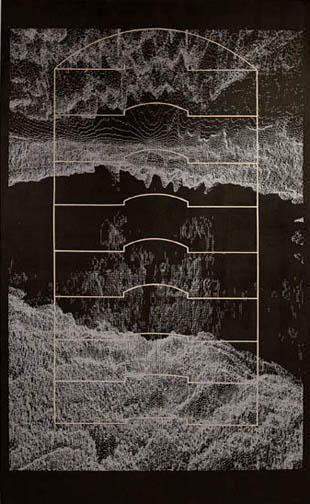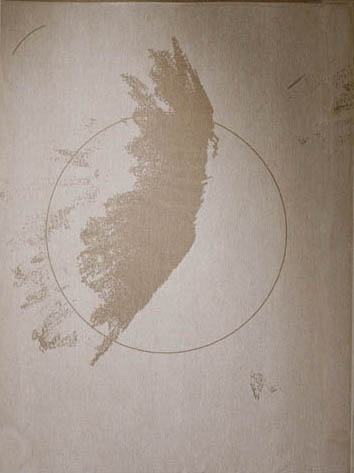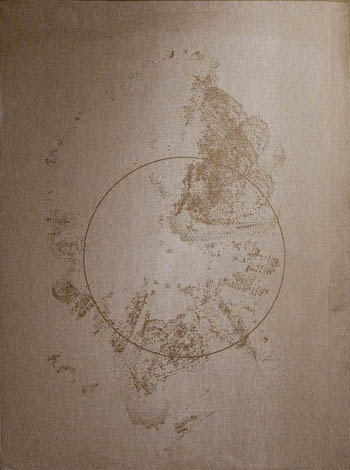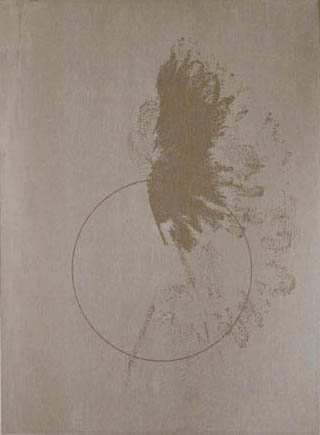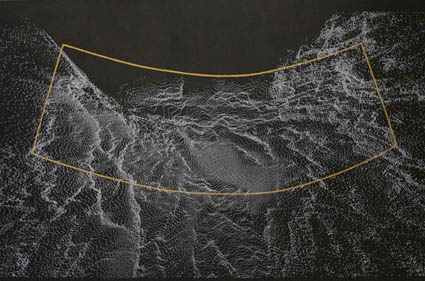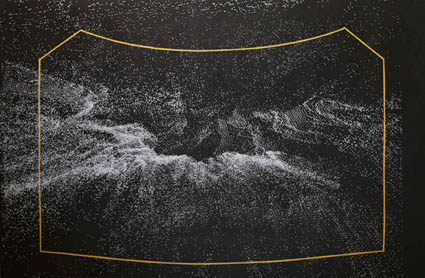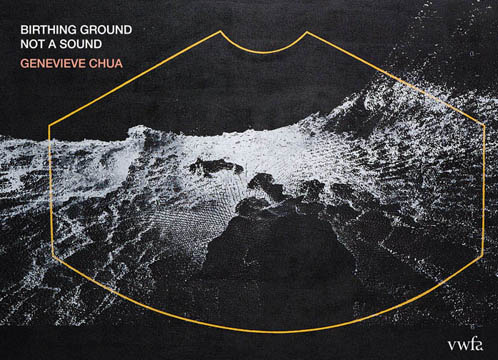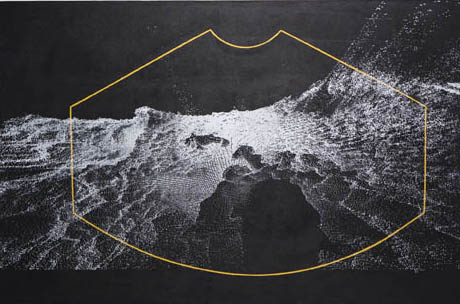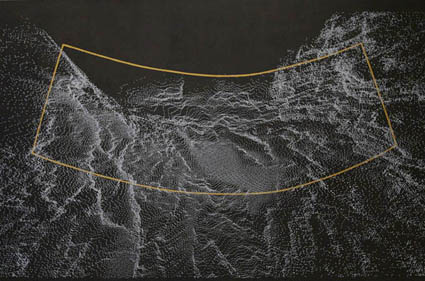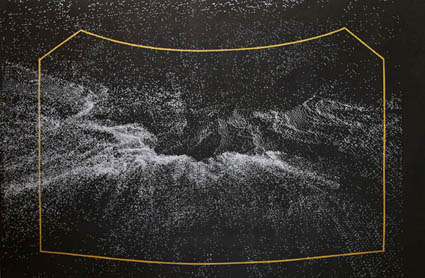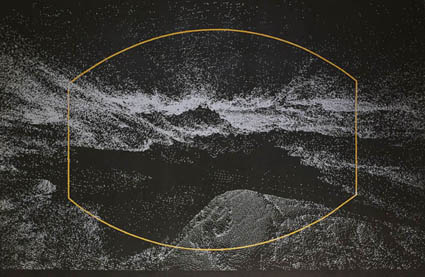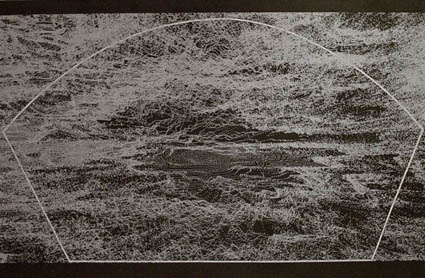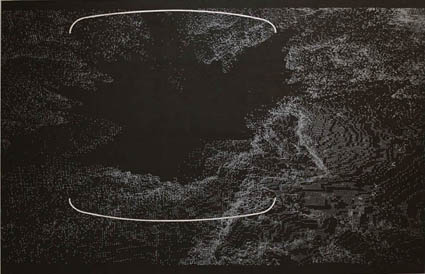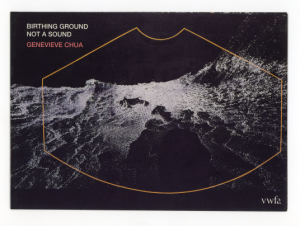Genevieve Chua
BIRTHING GROUND NOT A SOUND
VWFA Singapore is proud to present the gallery’s first solo exhibition by up and coming young Singaporean artist Genevieve Chua. Actively exhibiting in the Singaporean art world since 2003 Chua’s practice explores the psychologies of fear through the narratives of Southeast Asian horror. Multi-disciplinary in nature, her latest solo Birthing Ground Not a Sound looks at what lies within the silences of reclaimed subterranean spaces.
The exhibition begins, just after a flood has washed large quantities of earth from the surrounding forests into an anonymous shopping mall. Each particle then takes on a life of its own as they are hypnotically drawn –via an unknown force — though this multi-levelled space into a mysterious underground chamber or ‘birthing ground’. This primal dissent is charted through works that echo the aesthetics of ultrasounds and have been influenced by the stages of the underworld from Inferno, the first part of 14th century Italian poet, Dante Alighieri’s epic poem The Divine Comedy. Creating various frictions of space, aesthetics and narrative, the exhibition provokes a tense anticipation –for they are never directly referred to — of who, or more importantly what, emerges when super natural forces are invoked.
The Hole
Fear is an innate emotion, induced by a perceived threat to our survival. It creates an adrenalin inducing state of anxiety, panic and vulnerability around the real and imagined. Importantly, what we are afraid of, is also a highly revealing entry point into the hidden recesses of the human psyche, inspiring various creative genres that use characters and characteristics of fear to analyse, entertain and disturb us. Stories of these ‘monsters in the dark’, human or otherwise, have thus created an enduring human fascination with horror, folklore and legends. Fear is thrilling. Genevieve Chua explores these attractions through a multi-disciplinary practice inspired by Southeast Asian horror stories. Her latest solo Birthing Groud Not a Sound at Valentine Willie Fine Art Singapore looks at the tensions of space that occur above and below ground; beginning just after a flood has washed large quantities of earth from the surrounding forests into a shopping mall titled ‘ The Cascade’. Each particle of dirt, then takes on a collective life of its own as it is hypnotically drawn, via an unknown force, through this multi-levelled space into a mysterious underground chamber or ‘birthing ground’. This primal dissent is charted through painted works that echo the aesthetics of ultrasounds and has been influenced by the stages of the underworld from Inferno, the first part of 14th century Italian poet, Dante Alighieri’s epic poem The Divine Comedy. Creating various frictions of space, aesthetics and narrative, the exhibition provokes a nervous anticipation –for they are never directly referred to — of who, or more importantly what, emerges when super natural forces are invoked.
Genres of horror typically amplify tension by a sensory manipulation of our primal fears, nightmares and revulsion for the unknown. Psychologically this relies on characters’ emotional instability in order to build up discomfort in an increasingly threatening environment. The main source of this is usually the idea of evil, via a force, event or person that can sometimes be supernatural. However, Genevieve Chua does not aim to terrify her audiences with beasts and ghouls, but rather, by using elements from Southeast Asian ghost stories: animal spirits, pontianaks (a vampiric female ghost who has died whilst pregnant), suffocating flora and fauna and ominous floods, she creates haunting anxieties of space. Her ambiguous human characters (present or inferred) never directly inspire fear, or any emotion at all, instead, visual plotlines are fuelled by suggestion, absence, paranoia and longing. Revolving around lost or displaced beings/places that search, try to reclaim, overwhelm or return to their point of origin, her narratives often utilise some type of Singaporean reality that evolve into an imagined series of ongoing events. For Birthing Ground she weaves together the recent discovery of dead bodies in Bedok Reservoir, flash floods on Orchard Road and a connection between the multi-levels of ION Orchard shopping mall with the levels of Hell in Dante’s classic Inferno[1]. Installed in a chronological manner, each group of paintings reference specific events in this ominous narrative: the flood itself, its detritus and residue followed by the rhythmic retreat of soil through the shopping mall into the nesting ground. However, the works themselves are not descriptive but rather ambiguous abstractions, composed via computer rendering and silkscreen on canvas. Each presents a sinister type of presence and movement, filled with silence but fuelled by a ‘sacred and sordid’ purpose to seek out, nourish and give life. As a prelude to the awakening of ambiguous and potentially threatening forms, the exhibition therefore presents what Chua terms a ‘cusp’ event that refuses a narrative climax, and instead encourages the possibility of what could happen next.
These dramatic cliff hangers are visually created through the artist’s obsession with physical and psychological space. The setting for the exhibition is ‘The Cascade’ a fictional shopping mall modelled after the popular ION Orchard located on Orchard Road, which has four levels above ground and four levels below ground. During one particular visit, Chua, standing on one of the upper, less populated floors, glanced downward, and was immediately struck by the sense of chaos of shoppers in this environment. This mass movement, of multiple bodies making up a collective whole, driven by the same purpose was then reconfigured into a parallel world. Constructed as various observation points that look through and into space, she selected the use of ‘ultrasound echoes’ to create each image. Within the context of the narrative, these would have been taken outside of the shopping mall, but in reality have been constructed digitally. Layered onto the surfaces of each work are white or orange outlines that mimic the shapes of these sonic displays. By drawing the eye inwards through the frames and then, via the configuration of the particles, visually dropping downwards, Chua affects the primal gravitation to the birthing ground. Stepping back even further, viewers can see how this takes place throughout The Cascade itself in The Cascade, Upper Floors and The Cascade, Underground where the architectural outline of the shopping mall and its floors are depicted as the stage for a mass underground descent. The curvature of the final basement level (and site of the nest) in these two works finally alludes to the artist’s interest in the notion of the hole in the ground, or foundational cavity, from which most buildings are built upon. Acting as a type of cradle for the structure, it easily, morphs into a metaphor for the womb. However, visually, the tone of the exhibition is set through the claustrophobia of darkness and empty spaces that shroud Chua’s tale in mystery. The large black images (as well as lighter Detritus works) are filled with hundreds of particles, dense and thick with silence. The use of the ultrasound, a non-invasive method of mapping matter creates a mixture of volume and emptiness. What viewers see, like the watery catastrophe that displaced them, is a flooding of space, of pulsating and throbbing particles, like a conquering force – similar to Chua’s destructive all encompassing ivy in After the Flood. Empty of any type of human presence (all were safely evacuated) we as viewers are witnessing an imminent invasion of space.
However, although Birthing Ground is an unfolding anxiety of fiction, it is more rooted in Singaporean realities than one would originally think. Much of Genevieve Chua’s work is a discussion around a fear of the wilderness interwoven with folklore. But this is a distinctly localised fear, commenting on a Singaporean culture obsessed with excessive landscaping and urban planning. A culture paranoid over chaos and dirt, that prohibits, fears and ignores overgrown ‘wild’ areas of nature – often found directly behind built up areas like Orchard Road. Instead, Nature is something managed and manicured and then experienced via the comfort of an air conditioned room. Birthing Ground, purposefully takes elements of the wild and uncontrollable: water and dirt from the forests in the perimeter of the city, and channels this into a highly controlled (and much beloved) environment: the shopping mall. By disrupting and sullying this site of articulated consumption Chua blurs and transforms the boundaries between the acceptable and the prohibited. Although there is no visual sense of filth or abjection in her works, this visceral subtext is an important anchor to her work. It aims to provoke a local distaste and perhaps official unease towards untamed chaos. So, unlike the epic poem, Inferno which charts Dante’s journey upwards through Hell towards God’s salvation, Chua’s visual descent downwards, represents both a fear and perhaps a necessary embrace of the darker sides to life for new beginnings.
By Eva McGoverns
Head of Regional Programmes, Valentine Willie Fine Art
[1] Inferno is the first part of Dante Alighieri’s epic poem Divine Comedy an allegorical telling of the journey of Dante through Hell, who is also guided by the Roman Poet Virgil. It represents the journey of the sould towards God, with Inferno describing the recognition and rejection of sin.
